This strikes me as sort of an odd “where to begin”, but so be it. Almost immediately upon coming into this area I began to have memories of Viet Nam walking around in my head. I want to be quick to add, (so my sister doesn’t freak out), it wasn’t a bad thing. 🙂 There were no horrific flash backs, just lots of old visuals of muckin’ about in the bush. In the end, it was another comforting reminder that I am able to walk right up to that line without being pushed over it. It’s always been fascinating to me how distant it seems, but at times, so very near. Did I just write something that’s understandable? I’m not sure. But I thought it would be an interesting thing to share. The mountains of northern Guatemala are just like the central highlands of Viet Nam. A blending of vegetation that’s a mixture of forest and jungle. Beautiful and intimidating at the same time. Oh, and did I mention hot and humid? ‘Nuff about that.
Let’s restart with the Howler Monkeys shall we? These guys are an interesting lot. And I’m starting with them because I know I’ll refer to them again.
There are signs around the park reminding visitors that they like to try to defecate on people. The benign version is, they are just showing their presence, but I like to think there’s a little distain in there for us humans. A reminder they can have the upper hand so to speak at times. Glancing around on the ground is evidence that you don’t want to be caught under their ploppage. They’re called Howler Monkeys because they howl and growl. Think of the nature things about the big African cats you’ve seen on TV. The sound they make when they roar and grunt. It’s like that, only from a smaller body and chest cavity, so it’s not as deep and guttural. But still oddly similar. I can tell you this; they can, and do, make a racket. And of course there’s the poop. There are also Spider Monkeys in the park, but when I tried to shoot pictures of them, you couldn’t even tell what it was. They’re small, stay high in the canopy, and never seem to stop moving.
I was supposed to go on a tour with a guide on the first morning. But something happened and the guide couldn’t make it. I was told I could do it in the afternoon, or tomorrow morning, so I went wanderin’ off to the checkpoint and into the park on my own. See what I did there?
In what serves as a small market and visitor center is this scale model map of the area. The ruins are quite spread out, and and some still very encroached by jungle. The area of the ruins, which was this Mayan population center, is a little over six square miles and contains about 3000 different structures. The greater Tikal National Park and Preserve is about 220 square miles. Most of the walking is up or down. Some of the main trails are very “finished”, but many that branch off to smaller ruin sites are narrow and rugged. That little red temple model, in almost the exact center of this photo, is Temple 4. I’ll be getting back to that one in another post.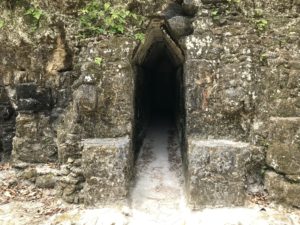
This inviting little guy was in the very first ruin group I hiked to. Close inspection revealed there were footprints going in, but none coming out. Hmmm. C’mon, I’m messing with ya. Once I got into the dark, the tunnel turned about forty five degrees to the right and there literally was a light at the end of the tunnel. 🙂 The tunnel was about 25 meters long and came out the back of the structure.
Most of the larger structures in the park are either temples or what they call acropolis areas. These would be residential areas where, for lack of a better term, the movers and shakers lived. Political leaders, people of wealth, family members of the chiefs, etc. The normal people living throughout the area lived in wood structures with thatched roofs. At it’s height, it’s estimated that about ninety to one hundred thousand people lived here from 800 BC to about 900 AD.
I made my way to what is essentially the jewel of Tikal, The Grand Plaza. From the park entrance it’s a twenty five minute hike, all uphill. The Plaza, undoubtedly the center of this Mayan population group, has temples on each end with acropolis areas on both of the other sides. This is the temple of the Grand Jaguar. Jaguars were revered by the Mayans. Did I mention there are jaguars in the park? If you ask almost any local they’ll tell you they have seen them, even in the daytime. I had no such luck. Below are two photos of the more prominent of the two acropolis sides on the Grand Plaza.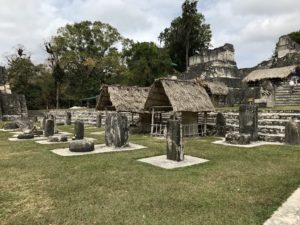
The thatched covering to the far right of the first photo is over this mask that was discovered underneath the acropolis and excavated. The round stones in the photos are the alters where blood sacrifices were done. They were, and can be found, all around Tikal. Some are original excavated altars and some are replicas. I spent a lot of time researching the history of human sacrifice practiced by the Mayans. In the end, I’ve chosen not to write about it. It’s a macabre rabbit hole you can do on your own if you want. Both written and archeological records suggest that at some point the Mayans stopped sacrificing humans and switched to animal sacrifice. The reasons for this are only a matter of speculation. Here are some other photos from around the Grand Plaza.
In this first one I’m standing at the base of the Temple of the Grand Jaguar looking straight up the steps.
It was early afternoon and I was hungry and feeling the effects of the heat and humidity, as well as getting up at 3:30 in the morning. So I made my way back down to the Tikal Inn for some lunch, some dog soaking, and a nap. Tomorrow was going to be another 3:30 wake up. That little story will be next.
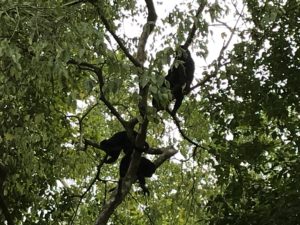
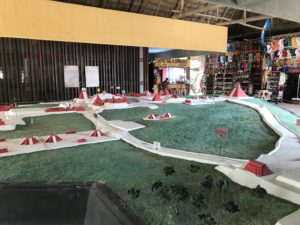

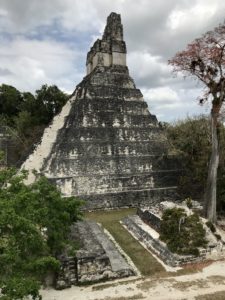
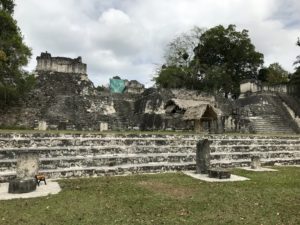
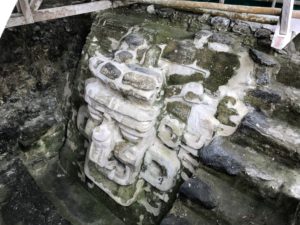
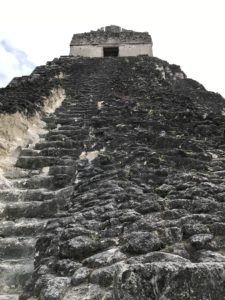

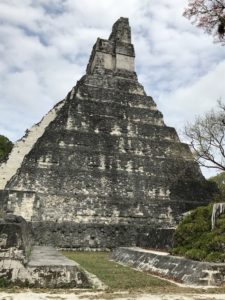
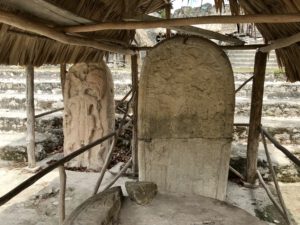
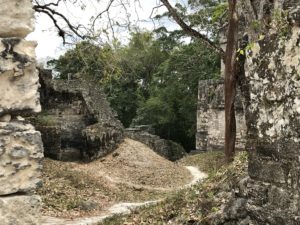
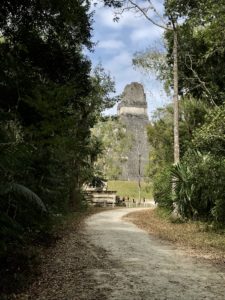
OK, this post is awesome, and I wish I could have been there with you. Pooping monkeys and all.
These Mayan ruin photos are amazing to me. I’ve always been fascinated by the building skills of ancient people.
You bring up a good point with the darkness that I often hear about on the history channel. When the ancient people were building all the beautiful and close to perfect structures, tombs, and tunnels what was their light source? Hard to believe it was with fire alone considering the heat, smoke, lack of oxygen, etc. Thoughts?
Well, my stupid smart ass response of course would be, why wouldn’t they just use their phone flashlights.
My more serious thought would be; although I’m sure there were times when they smoked themselves out with torches
going in and out, during construction, I’m guessing the tunnels and tombs were placed while the temple or acropolis was being built.
So they wouldn’t get completely enclosed until the courses were constructed above them. I’m also guessing you may have already thought
of that.
Wait-there are monkeys out there that howl, growl, and like to poop on people? My perception of those cute and funny little creatures is forever changed.